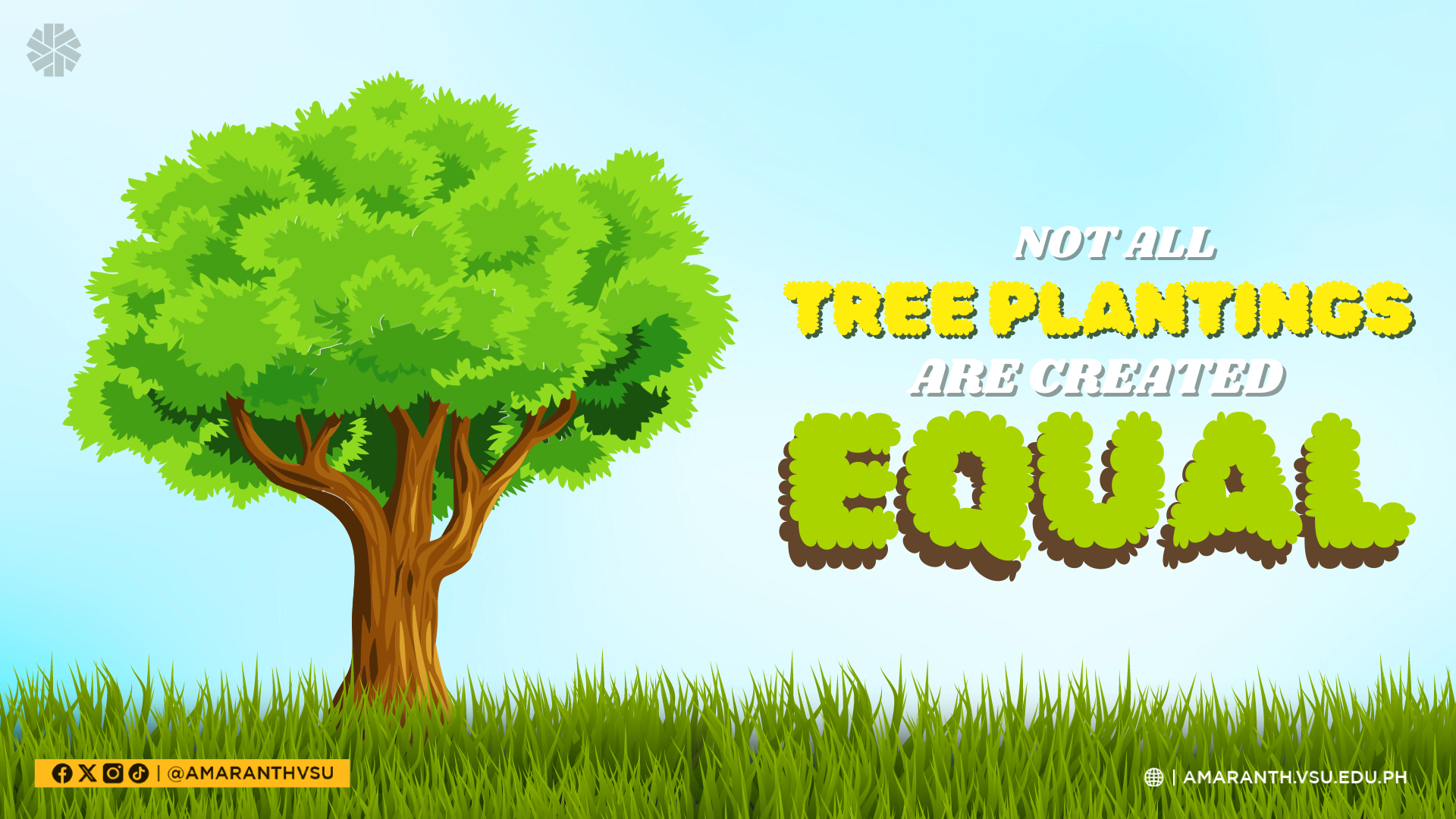According to meteorological authorities, El Niño in the country for the year 2023-2024 is one of the strongest recorded. “Heat Index” (the physical sensation that humans feel from the heat) continues to become the talk of the town as the unbearable temperatures unceasingly blaze the country affecting crops, livelihood, and health. Numerous universities in the Philippines have shifted their classes to asynchronous as a part of their mitigation measures against the heatwaves.
This inevitably compels people to advocate for tree planting as a solution, as after all, they are scientifically proven to make spaces cooler. So obviously this implies that we should plant trees as much as possible, right?
But… should we plant trees? Of course, we should, but the answer is not as straightforward as we might think. As Viscans, it should be second nature for us to be acquainted with the basic concepts of environmental science. So here are things that we need to consider before burying seeds in the closest soil to us:
Identify the Purpose
Of course, it’s not rocket science, but before we start plowing the ground, we must take a seat first and assess the purpose of our tree planting. Because more often than not, tree planting without careful planning and execution can do more harm than good for the environment. Unfortunately, without following proper procedures, they are likely to be unsuccessful as species do not survive in the long run which will be a loss of money, time, and effort.
So to make our activity more realistic, we have to ask the following questions: do we want to start planting trees for food security? Biodiversity? For cooler temperatures? For sequestration of Carbon Dioxide? For water? To preserve the cultural heritage of our community? For restoration? For production? There are many reasons to plant trees and these are only some of them, ultimately, we should be sure of our objectives before starting.
Set the Timeframe
Some tree species can take centuries to grow to their full maturity, so we should be specific enough to know what our objectives are and how long our project is going to take to be more successful in our endeavor. This is done so that our expectations are measured on the results that we desire and that the planting materials gathered are appropriate to use.
Know the Tree Species
We should get to know the species that we want to introduce in our area. There are three types of identifying species based on their habitat distribution: Exotic, Native, and Endemic. This is important to know to guarantee that our tree planting will bring benefits to the local ecosystem rather than harm.
Exotic species are trees that are not originally from the area and are only introduced. Examples of these would be Mahogany (Swietenia macrophylla) and Raintree (Samanea saman).
On the other hand, Native species are trees that have already existed within the area since time immemorial– Narra (Pterocarpus indicus) and Banaba (Lagerstroemia speciosa) are some examples of trees native to the Philippines.
Lastly, we have Endemic species; they can also be deemed native species but their distribution is much more specific to a location and more often than not cannot be found elsewhere. For example, Narra is native to the Philippines, while on the other hand, Mangkono (Xanthostemon verdugonianus) is endemic only to the islands of Palawan, Visayas, and Northeastern parts of Mindanao but it can also be considered native to the Philippines.
In choosing the tree seedlings that we plan for our activity, it is best to avoid planting exotic species. This is because they are not adapted to the area's conditions and are less resilient against disease outbreaks and natural disasters. Additionally, they can cause disturbance to the ecological balance for a lot of the plants, animals, and insects that rely on a healthy ecosystem to survive. They can also be classified as an Invasive species.
For example, invasive species such as Mahogany produce chemicals within the soil that wipe out competition, resulting in the decline of important native populations, a phenomenon called Allelopathy. Additionally, several literatures from journals such as Nature and Elsevier found that some species, when planted in the wrong place, can impact the moisture levels of soil due to its high absorption of water causing the ecosystem to become more fragile than ever before. These are only glimpses of what will happen when tree planting is done incorrectly.
Therefore, if we want to make tree plantings more effective, we must choose tree species that are suited to the area which are usually native or endemic tree species. It is also important that we introduce as many species as possible to achieve biological diversity. Rainforestation technology, which was promoted by Viscan pride Dr. Paciencia Milan and Dr. Josef Margraf of the German Agency for Technical Cooperation (GTZ), is a technology that is highly effective due to its usage of diverse native tree species.
Despite the emphasis on using native species in tree planting, exotic species should not be villainized altogether. There are cases when they can be utilized for reforestation in areas such as abandoned mining sites as they can help restore the area from its degraded state much better compared to their native counterparts; this method is called Phytoremediation. However, such a strategy is only advised to be used by experts in the field.
Often it is hard to tell whether a species is exotic, native, or endemic which is why when we plan on knowing which is which, it is best to consult a tree expert, rely on research papers, or tree encyclopedias existing on the internet or a library near you.
Consult the Experts
Suppose we want our tree planting to be more successful. In that case, it is best to ask the professional advice of licensed foresters, indigenous peoples, and scientists who are experts in forest science in general. They are equipped with enough knowledge to survey the area and assess the biological, ecological, climatic, and edaphic (soil) conditions and demands to be met while simultaneously taking the community's needs into account. They will do this before giving the appropriate prescriptions for planting and maintaining the seedlings to ensure their survival.
At the end of the day, we all want to see more green spaces in our communities. But simply advocating for tree planting is not enough, we must give more importance to tree caring and tree growing and ensuring that the species planted will survive, thrive, and bring benefits to the local ecosystem and human communities coexisting in the area.
Fact-checked by Dr. Renezita S. Come


